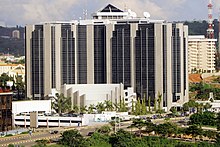
Back البنك المركزي النيجيري Arabic Central Bank of Nigeria German Banco Central de Nigeria Spanish Nigerian keskuspankki Finnish Banque centrale du Nigeria French Babban Bankin Najeriya Hausa Central Bank of Nigeria Italian ナイジェリア中央銀行 Japanese A̱gba̱ndang A̱lisaaikurum Naijeriya KCG 나이지리아 중앙은행 Korean
 | |
 | |
| Headquarters | Abuja, FCT, Nigeria |
|---|---|
| Established | 1958 |
| Ownership | 100% state-owned[1] |
| Governor | Olayemi Cardoso |
| Central bank of | Nigeria |
| Currency | Nigerian naira NGN (ISO 4217) |
| Reserves | 28.28 billion USD[1] |
| Bank rate | 18.7% (July 2023)[2] |
| Website | www |
The Central Bank of Nigeria (CBN) is the central bank and apex monetary authority of Nigeria established by the CBN Act of 1958 and commenced operations on 1 July 1959.[3] The major regulatory objectives of the bank as stated in the CBN Act are to: maintain the external reserves of the country, promote monetary stability and a sound financial environment, and act as a banker of last resort and financial adviser to the federal government. The central bank's role as lender of last resort and adviser to the federal government has sometimes pushed it into murky regulatory waters. After the end of imperial rule, the desire of the government to become proactive in the development of the economy became visible, especially after the end of the Nigerian civil war, the bank followed the government's desire and took a determined effort to supplement any show shortfalls, credit allocations to the real sector. The bank became involved in lending directly to consumers, contravening its original intention to work through commercial banks in activities involving consumer lending.
The major regulatory objectives of the bank as stated in the CBN Act are to: maintain the external reserves of the country, promote monetary stability and a sound financial environment, and act as a banker of last resort and financial adviser to the federal government. The central bank's role as lender of last resort and adviser to the federal government has sometimes pushed it into murky regulatory waters. After the end of imperial rule, the desire of the government to become proactive in the development of the economy became visible, especially after the end of the Nigerian civil war, the bank followed the government's desire and took a determined effort to supplement any show shortfalls, credit allocations shoot to the real sector. The bank became involved in lending directly to consumers, contravening its original intention to work through commercial banks in activities involving consumer lending.
However, the policy was an offspring of the indigenization policy at the time. Nevertheless, the government through the central bank has been actively involved in building the nation's money and equity centres, forming securities regulatory boards, and introducing treasury instruments into the capital market.[3] The bank has thirty-six branches each in the 36 states of the federation and the headquarters in FCT.[4]
- ^ a b Weidner, Jan (2017). The Organisation and Structure of Central Banks (Thesis). Darmstadt: Universitäts- und Landesbibliothek Darmstadt.
- ^ "Nigeria central bank raises main lending rate by 25 basis points". Reuters. Retrieved 25 July 2023.
- ^ a b "History of CBN". cenbank.org. Central Bank of Nigeria. Archived from the original on 6 July 2016. Retrieved 25 September 2018.
- ^ "List of CBN Branches in Nigeria and their Locations". nigerianfinder.com. Retrieved 7 February 2022.
© MMXXIII Rich X Search. We shall prevail. All rights reserved. Rich X Search